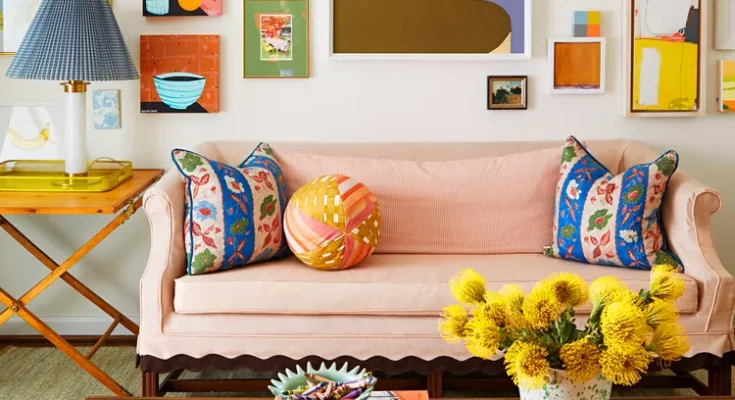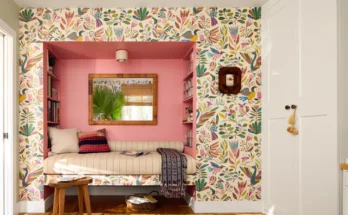Whether you’re buying new or updating your current setup, steering clear of these common sofa missteps can make all the difference.
Most sofas aren’t exactly cheap, and since you’ll likely spend a lot of time on yours, it’s worth knowing what to avoid when it comes to purchasing and styling one. To help ensure your next couch-buying and styling process is a smooth one, furniture designer Ashley Redmond shares the top eight sofa-related mistakes she sees all too often. From how to measure properly to understanding the role the right fabric can play, Redmond’s pro tips can help you master your sofa strategy like a pro.
1. Disregarding the Layout and Style of Your Room
“Room shape is everything,” says Redmond. For a long, narrow space, the design pro says a sectional might be needed to provide an anchoring effect, while a square room is often in need of a slightly more compact sofa that can be paired with accent chairs. The key is to make it feel intentional, rather than looking like the room and sofa are battling against each other. “In a loft, go big with modular or oversized pieces to match the scale,” says Redmond. “In a traditional space, something more tailored—think structured arms or tufting—complements the architecture.”
2. Not Measuring First
Grabbing your tape measure should always be the first step in your sofa-buying journey. Redmond advises measuring the length, width, and height of your space, then determining where your sofa will be situated. “Think about how you move through the space, what the focal point is (like a fireplace, TV, or beautiful view), and how you use the room,” she says.
Beyond the size, also consider how the sofa will feel in the space. Determining if traffic flow will suffer and if the sofa will feel overwhelming are both questions the designer urges clients to consider. If you’re working with a small space, Redmond suggests a low-profile, armless, or modular style that can lend a more open feel. Finally, consider modifying your existing furnishings by moving things around to see what will work best for the way you use the space, Redmond says.
3. Forgetting to Check Install Measurements
“Pivot!” Take it from Ross Geller—properly measuring doorways, stairways, and hallways before you find yourself on the front end of a sofa trying to hoist it over a stair rail is key. If you have narrow openings leading to the room in which the sofa will be installed, you might need to consider a smaller sofa than the room could otherwise afford. If you have a narrow entry, consider the dimensions of the sofa with the feet off (if they’re removable), opt for a sofa that can be disassembled, or go for a brand like Albany Park that ships in compact boxes.
4. Not Considering Lifestyle Needs
The right sofa isn’t all about size and proportions, but should take into consideration lifestyle needs as well. “In busy family rooms, go for durable performance fabrics and deep, loungey silhouettes,” says Redmond. “In more formal rooms, opt for clean lines, lower backs, or firmer cushions.” The key is to land on a fabric that toes the line between livable and polished so you’re sofa can just as easily switch from after-work lounging to entertaining at a moment’s notice.
5. Going Matchy-Matchy
If we know one thing about design trends in 2025, it’s that collected is in—and that goes for your sofa and surrounding furnishings as well. “If your sofa is sleek, try a round or textured coffee table to soften the lines,” Redmond says. Working with a retailer that offers design services or pieces that work well together can help you achieve your style goals. “Our upholstery is made to mix and match, and our cohesive palette makes it easy to pull together a look that feels layered, not forced,” the designer says.
6. Underestimating the Power of Your Fabric Choice
“Lighter tones and smoother fabrics help a sofa feel visually lighter, while bolder colors or heavy textures can make it feel more grounded (or heavier),” says Redmond. If you want to find the sweet spot between form and function (where comfort is key), the design pro suggests opting for a deep sofa with a neutral performance fabric to lend an airy feel that doesn’t sacrifice an ounce of comfort. Always remember that the right sofa will blend both comfort and looks. “Choose a style that fits your aesthetic, but don’t skip comfort testing—seat depth, cushion fill, and how it supports you matter.”
7. Placing the Sofa Against the Wall
According to Redmond, floating placement of a sofa can be transformative in a room, particularly with open layouts. In more open spaces, furniture placement can carve out zones and aid in creating the ideal flow. “Against the wall works when space is tight, but don’t default to it,” she says. Instead, opt for a sofa that looks good from all angles and can easily be pulled away from walls to create more definition in your space.
8. Skimping on Placement
You found a sofa in the perfect size, color, and fabric—your work is done, right? Not so fast. Now you’ll need to ensure you have the proper clearance between your sofa and the other furnishings within the space. This can not only help your room feel properly proportioned but can also enable easy flow throughout the space.
Redmond suggests allowing 30 to 36 inches for walkways around your sofa and 18 inches for the space between your sofa and coffee table. “It’s the sweet spot between functional and relaxed,” she says. “You don’t want a coffee table so far away you can’t easily set a drink down.”



